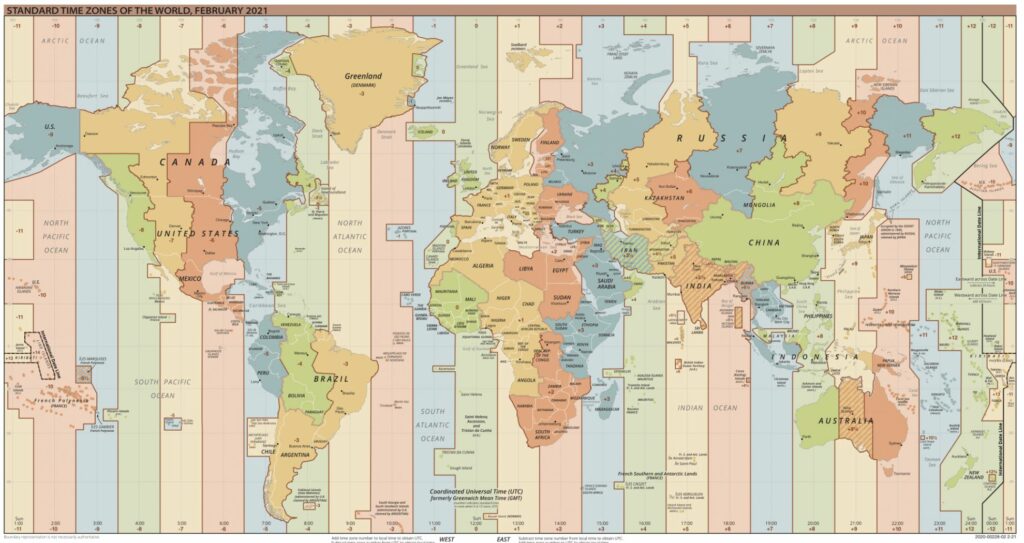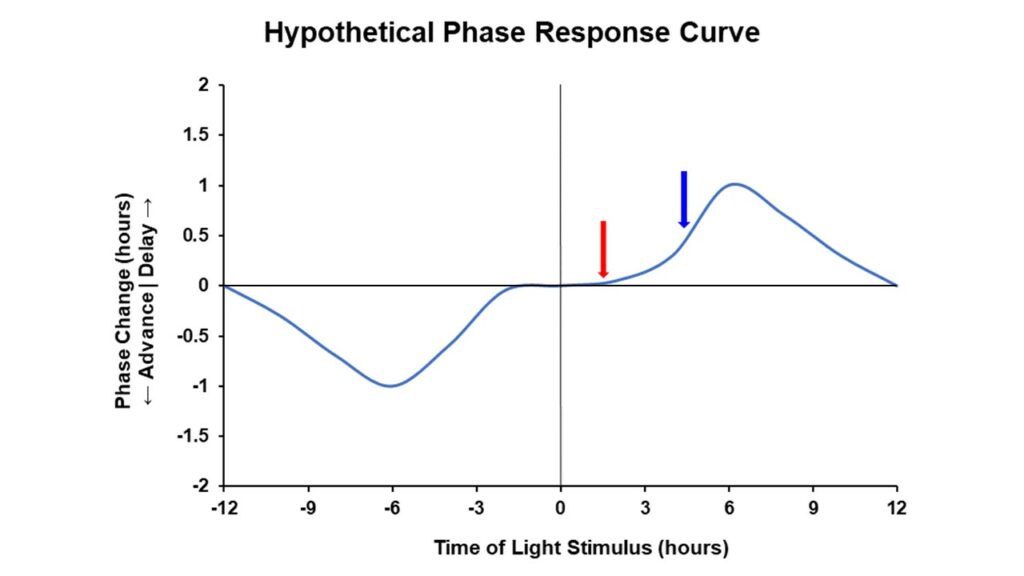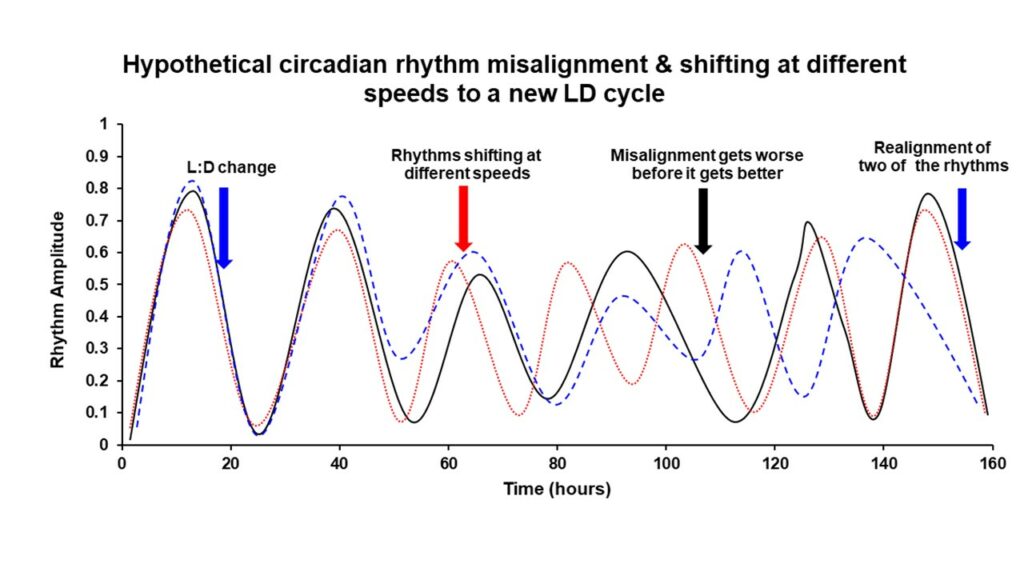
Physiology News Magazine
Avoiding the traveller’s blues
Understanding the physiology of jet lag
Features
Avoiding the traveller’s blues
Understanding the physiology of jet lag
Features
Dr Philip Lewis, University of Cologne, Germany
Professor Thomas C Erren, University of Cologne, Germany
https://doi.org/10.36866/122.22
After the potential easing of lockdown restrictions was announced by the UK government in late February/early March, there was a flurry of holiday bookings to destinations abroad (BBC, 2021). If you are one of those with plans in place to go hopping over a few lines of longitude later this year (with destinations from Turkey to Mexico mentioned in reports), good timing will be necessary to avoid the traveller’s blues. We do not mean good timing insofar as avoiding the disappointment of cancellation due to travel restrictions and public health priorities (although, of course, we hope this will not be the case for you). Rather, we mean from a biological time-keeping perspective to avoid the traveller’s blues known as jet lag.
We all know what jet lag is…right?
Asking around might get you the answer, “it is when you have difficulty sleeping because your body has not adjusted to the new time zone”. This doesn’t sound too bad. There are nights when we do not sleep well but manage okay the next day. You might try the online blogs to get a sense of what is known by the wisened travellers. These descriptions of jet lag can be more colourful: “drowsy at that late-afternoon meeting … and every fibre of your being screams out ‘go to sleep’ … trying to avoid the gerbil wheel of anxiety that kicks in when you’re awake in the middle of the night” (Williams, 2017). This sounds a bit worse. The medically orientated websites get a bit closer. The first few sentences on the NHS website are: “Jet lag is when your normal sleep pattern is disturbed after a long flight. It usually improves within a few days as your body adjusts to the new time zone” (NHS, 2020). Scrolling to the bottom of the page we can find: “Jet lag can also sometimes cause dizziness, indigestion, nausea, constipation, changes in appetite and mild anxiety.” This is getting closer to the truth as it includes a few more symptoms of jet lag but still not quite there.
A flight from the UK to South Africa will take 11-12 hours – without question a long flight – but you won’t experience jet lag. Fatigue and dehydration and their knock-on effects – caused by stress, high altitude, and long-haul – will be experienced, sure. But this is not jet lag in the conventional sense. The time difference between the UK and South Africa is 2 hours, meaning you might be having brunch instead of breakfast in South Africa. In contrast, the time difference between the UK and Mexico is 6 hours even though flight duration is approximately the same as UK to South Africa, meaning you may be getting hungry for breakfast at 2am in Mexico. Even the 6-hour time difference does not sound so bad if this were the only symptom. We could survive being hungry for a few hours until breakfast (just about) or could stay awake a few hours extra when needed (this will not be lost on lab bench physiologists) on the first evening at a new destination.
The trouble arises when the body attempts to adjust to the new time zone, which really becomes conspicuous from 24 to 48 hours after arrival, and can get worse before it gets better. The crook of the matter lies in circadian biology.

Circadian biology
Physiology comes with an innate circadian timing system (CTS). An expression loop of core clock genes with a period of ~24 hours (circa dian = approximately a day) gives rise to rhythmic expression of proteins, cell processes, and signalling, scaling up to rhythms in tissues, organs, and integrated physiology. These core clock genes are present in every cell; thus, we have a clock in every cell. When the clocks are synchronised, circadian rhythm in various integrated physiological processes can be observed. For instance, peaks in cognitive and physical performance can be reached that would otherwise be unreachable if clocks were not in synch. Coordinating the clocks is a central pacemaker situated in the suprachiasmatic nuclei (SCN) in the hypothalamus region of the brain. Neuroendocrine output from the SCN is the coordinating link to the rest of our cellular clocks. Peripheral clock feedback to the SCN is not as well understood.
Peaks in cognitive and physical performance would be no good to us if they occurred in the middle of the night rather than in the middle of the day, so the central pacemaker responds to the light and dark conditions of our environment to synchronise with the daily light–dark cycle. Retinal ganglion cells in the eyes, which express the light-sensitive protein melanopsin, note the prevailing light conditions and send a signal down the retino- hypothalamic tract to the SCN. The SCN output depends on the relative signal strength and timing (relative=relative to light history) of light. For instance, experiencing light a bit later in the evening than would be expected typically serves to phase delay circadian rhythms. As examples, the secretion of melatonin, which begins shortly before sleep, is delayed when evening light is prolonged and the night-time drop in core body temperature will also be delayed. This forms part of the rationale for not using bright, light-emitting devices at night as they can affect our circadian rhythms. We all present with phase response curves to light, insofar as the timing of the signal will have different strengths of delaying or advancing of rhythms (Fig. 1).
Clocking the traveller’s blues
So, you arrive in the new destination, some lines of longitude away from home. For example, let us take a 12-hour difference in clock time and you arrive at either 3pm or 3am. The jet lag process will already have begun in terms of mild phase delay or phase advance due to the change in the timing of light and dark and your phase response curve. It is typically understood that we can only phase-shift by approximately 1 hour per day, but digging a bit deeper has shown that individual rhythms shift at different speeds. Remember, we need to phase-shift clocks in all cells throughout our body and the subsequent rhythms that they give rise to. After ~12 to 24 hours, a shift of 1 hour might not be noticeable and peaks and troughs in rhythms will still be observed; albeit perhaps a bit earlier or later than usual and maybe a bit smaller in amplitude due to a small misalignment among the individual clocks of your body. You will still be prone to being awake at night and sleepy during the day at your destination; however, you could sleep well during the daytime should you choose to do so as your rhythms that contribute to restorative sleep are only mildly misaligned with respect to each other after this short period at the new destination. The same holds for reaching high performance levels, just these would occur at night at your destination. Our CTS can manage this quite well; indeed, elite athletes take advantage of this to align the peak in performance rhythm with event time at their destination (Mascaro & Facer-Childs, 2020).

In the following days, however, as your individual clocks continue to shift toward being more in line with the environmental time, they will initially become more misaligned due to this shifting at different speeds (Fig. 2). Some integrated rhythms may even become non-existent due to a lack of overlapping peaks and troughs in various cellular rhythms. This more severe misalignment gives rise to the poor sleep quality (regardless of sleep timing), dizziness, indigestion and nausea, constipation, changes in
appetite, and anxiety symptoms as described by the NHS website. Other symptoms, already noted as potentially important in the 1960s and 70s include perturbation of mood and decision-making abilities (noted for its importance to travelling business persons and diplomats) (Rockwell, 1975). You might take this into account when socialising with colleagues late into the evening or asking pertinent questions at the next annual physiology conference after trans-meridian travel.
These periods of disarray are what correspond to every fibre of one’s being screaming for sleep and determines the real traveller’s blues. Some people will suffer more or less than others due to experience with jet lag, age, stress levels, genetics, the direction of travel, and other factors that may affect how sensitive the CTS is to phase-shifting.
As days pass, cellular rhythms gradually come back into alignment and symptoms will disappear. The CTS will then be entrained to the prevailing conditions of the new environment (Fig. 2). In the case of a 12-hour time change, with the assumption that rhythms can shift by approximately 1 hour per day, it would take 12 days to become fully realigned, although some rhythms may align with the prevailing environmental time faster than others.
Prevention or cure?
Neither, unfortunately, or at least not completely if flying is a necessity (though we would encourage more eco-friendly travel and avoiding travel by plane). Melatonin is touted as a candidate pharmacological aid, but it must be timed correctly (in accordance with phase response curves to melatonin; similar to light in Fig. 1). Ultimately, it will not facilitate immediate adaptation to more extreme destination time zones. Melatonin does have, inter alia, sleep-promoting properties as it “opens the sleep gate” but this does not necessarily mean it will affect circadian rhythm. The purported benefits may stem simply from feeling more refreshed after sleeping. To exemplify some complexity, if you are flying into a destination at night time that would otherwise still be your day time (i.e. as might occur if you fly east – the sun rises in the east and sets in the west; thus, you and the setting sun approach each other), then taking melatonin may be useful to advance sleep. Your sleeping can also affect your light–dark exposure while travelling; thus, being asleep also means not experiencing light while travelling that would otherwise serve to delay sleep.
Asking “Google” for help may not always be ideal. An online newspaper article in 2019 claimed a pilot indicated a few glasses of red wine prevented his jet lag. This is definitely not recommended as alcohol decreases sleep quality. If you land on the NHS website, you will find good advice such as to avoid sleep and seek daylight during the daytime and use an alarm to prevent oversleeping in the morning. Regarding the latter, more gradual phase advance or delay of sleeping patterns might be preferred, if possible, to prevent rhythms trying to shift too far too fast (remember, different rhythms shift at different speeds and bigger shifts will mean more misalignment). Caffeine may be useful to increase alertness but will not speed up adaptation, rather it plasters over the temporarily decreased alertness. Also, it is unlikely to cover up other adverse effects of misalignment. But, be careful, as caffeine could make you feel worse once it wears off, and should not be viewed as a substitute for water, with dehydration being a consequence of air travel. Other tips to help with sleep include a hot bath or shower in the evening to hasten the change in core skin temperature ratio that is associated with sleep. There is a Physiological Society video on YouTube that suggests timed vasopressin in eye drops could become a remedy or “cure” (The Physiological Society, 2018). We remain sceptical as this is designed toward only affecting the CTS and not peripheral clocks.
Circadian rhythm phase-shifting can be kicked off prior to travelling and this is probably the best bet to beat jet lag by either delaying or advancing circadian rhythms in smaller increments (perhaps 30 mins per day). Seeking light just before bed and seeking more darkness in the morning will start the process of delaying sleep if you are travelling west. The opposite light exposures should be used for travelling east. Food timing and activity timing may also be shifted accordingly to provide benefit (Lewis et al., 2018, 2020). A little bit of chocolate for breakfast has been shown to aid entrainment to new light–dark cycles in rodents (Escobar et al., 2020) – something many could get on board with – although this may have something more to do with specific nutrient content than chocolate per se. Research into non-light circadian time cues is ongoing. Overall, pre-travel phase- shifting in smaller increments can prevent larger cognitive and physical deficits in performance and other jet lag symptoms.

Conclusion
So, to avoid the traveller’s blues if you find yourself crossing meridian lines this summer, Rockwell’s timeless letter, which already pointed to “both external desynchronosis (inside time versus outside time) and internal desynchronosis (with ≥ two rhythms being out of synchronosis with each other) associated with temporal translocations of three hours or more” and provides advice (from an American vantage) is still… well, timeless (Rockwell, 1975):
• For short stays it is best to stay on “home” time;
• When travelling west to east go to bed progressively earlier before the trip (vice
versa east to west);
• For important meetings leave several days earlier (our findings indicate that 48 hours
are needed for resynchronosis);
• Arrange important activities at your normal peak times – meet your European colleagues
in late afternoon or evening;
• Use food and alcohol sparingly during the flight and the first three days after arrival
– alcohol (and most tranquilisers and hypnotics) interferes with rapid eye movement (REM) sleep;
• On long transmeridian flights arrange a halfway stopover;
• Arrange your schedule to shorten the day rather than the night;
• Rest and relax for two days before working.
References
BBC News (2021). Holiday bookings surge after lockdown exit plans. [Online] BBC News. Available at: https://www.bbc.com/news/business-56161129 [Accessed 20 March, 2021].
Escobar C et al. (2020). Chocolate for breakfast prevents circadian desynchrony in experimental models of jet-lag and shift-work. Scientific Reports 10(1), 6243. https://doi.org/10.1038/s41598-020-63227-w
Lewis P et al. (2018). Exercise time cues (zeitgebers) for human circadian systems can foster health and improve performance: a systematic review. British Medical Journal Open Sport and Exercise Medicine 4(1), e000443. https://doi.org/10.1136/bmjsem-2018-000443
Lewis P et al. (2020). Food as a circadian time cue- evidence from human studies. Nature Reviews Endocrinology 16(4), 213–223. https://doi.org/10.1038/s41574-020-0318-z
Mascaro L and Facer-Childs ER (2020). Time to win gold. Physiology News 118, 36–40. https://doi.org/10.36866/pn.118.36
NHS (2020). Jet lag. [Online] NHS. Available at: https://www.nhs.uk/conditions/jet-lag/ [Accessed 20 March, 2021].
The Physiological Society (2018). Can we cure jet lag with eye drops? [Online] Youtube. Available at: https://www.youtube.com/watch?v=9z6fYJgDZDM [Accessed 20 March, 2021].
Rockwell DA (1975). The “Jet Lag” syndrome. West Journal of Medicine 122(5), 419.
Williams, DL (2017). Jet lag is a modern-day, self inflicted disease. [Online] The National News. Available at: https://www.thenationalnews.com/opinion/jet-lag-is-a-modern-day-self-inflicteddisease-1.95977 [Accessed 20 March, 2021].
